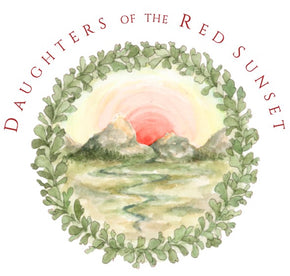Slow Making
Sustainable Making, Slow Fashion, Creating with Intention

For thousands of years humans have been using color to decorate their homes, their clothing, and themselves. Until very recently in our history, all of this color came from nature - roots, leaves, flowers, earth, sea shells, and even bugs. The tapestries and paintings that you still see hung on the walls of historical places are more than likely a mix of your three primary colors, Madder (shades of red), Weld (yellows), and Indigo/Woad (blues). In fact, it wasn’t until as recently as 1856 that the first synthetic dye was produced. Sir William Henry Perkin, a British Chemist, was attempting to synthesize a quinine treatment for Malaria when he accidentally stumbled upon the beautiful and intense purple color he later called Mauvine. From this discovery, the field of synthetic dyes grew. Because of their lower cost, ease of mass production, and dependable results, these dyes quickly replaced our naturally made colors. Unfortunately, these synthetic dyes have taken a great toll on our health and our environment. Recently, with awakening awareness surrounding the harmful effects of so many synthetic dyes, natural dyeing is beginning make a come back.
Our world right now is one of fast-paced technology. This can be an amazing thing on many levels, but it also disconnects us from nature. We have tried to build walls to separate ourselves from nature, physically and figuratively. But we are nature! We are born from it. We exist because of the air that we breathe and the water that we drink, just like the great Oak and bending Willow. We exist because of the foods that we eat, grown from sunshine, rain, and wind. The farther we get from this earth connection, the more we experience disharmony.

In the grand scheme of things, it has only been a short moment in time since the Industrial Revolution began. Things have gotten easy for us because of mass production, machinery, and technology. But through all of that, we have become disconnected from our relationship with nature. Our bodies have a deep need to understand and cultivate this relationship. We desire to feel the plants in our hands and tune our bodies into the rhythm of the seasons, especially when society has become so reliant on technology, become so high tech and out of touch with nature. In that short while since the industrial revolution we have begun to lose the knowledge and traditions that we have had in our cultures for those hand crafted things, including our medicines. It is my hope that what I create will become a part of your rhythm and connection with nature.
I grow many food, dye, and medicinal plants in my gardens. If I harvest outside of my gardens, I commit to leaving the areas where I harvest as I have found them. I make a promise to you not to contribute to habitat and ecosystem destruction because of my desire to print the brightest red, gather the perfect shaped leaf, or in creating medicine! I believe this art only becomes more beautiful when you grow, harvest, and create with intention and kindness.

